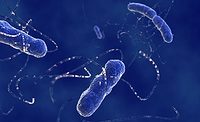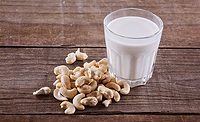The Silent Threats in Our Salad Bowls: Research Harnessing Plant Defenses to Combat E. coli and Salmonella Infections

Image credit: Rayia Soderberg via Unsplash
Foodborne illnesses caused by bacteria like Escherichia coli (E. coli) and Salmonella pose a grave threat to public health. Among the various sources of contamination, plant-based and salad-related illnesses have garnered significant concern over the last decade. These infections can have severe repercussions, especially for individuals with compromised immune systems, such as children and seniors. The fear of these bacteria lingers in people's minds, and it is crucial to address these concerns. This article explores the author's groundbreaking research shedding light on the dangers of E. coli and Salmonella, and how this work can help safeguard lives through improved food safety practices.
The Silent Threats of E. coli and Salmonella
E. coli and Salmonella infections are far from ordinary. These bacteria have the potential to cause severe illnesses, ranging from gastrointestinal distress to life-threatening conditions. The repercussions extend beyond physical suffering, with significant economic burdens and strain on healthcare systems. According to recent statistics, E. coli infections alone result in an estimated 265,000 illnesses, 3,600 hospitalizations, and 30 deaths annually in the U.S. Salmonella infections are equally concerning, affecting approximately 1.35 million individuals, leading to 26,500 hospitalizations and 420 deaths each year. These numbers reflect the urgency of addressing these pathogens and their impacts on public health.
E. coli and Salmonella infections are primarily caused by consuming contaminated food or water. One of the most common sources of both E. coli and Salmonella infections is through the consumption of raw or undercooked meat, especially ground beef and poultry. Additionally, fresh produce, including leafy greens, fruits, and vegetables, can become contaminated with E. coli or Salmonella through various means. Contamination can occur during cultivation, harvesting, processing, or distribution, when produce comes into contact with contaminated soil, water, animals, or improperly sanitized equipment. Importantly, poor food handling practices and cross-contamination in the kitchen can also contribute to E. coli and Salmonella infections.
Among those most vulnerable to the harmful effects of E. coli and Salmonella infections are individuals with compromised immune systems. Children, the elderly, and those with underlying health conditions face a higher risk of severe complications, making it crucial to prioritize their protection. For them, a seemingly innocent meal can turn into a life-threatening situation.
Greens, including lettuce, are often served raw as part of salads or garnishing in different recipes. This can pose a threat, as parents worry about the safety of the produce they serve to their children, and families with elderly members fear the consequences of contaminated salads. The fear is real, and the need for robust food safety practices becomes paramount to safeguard the well-being of these vulnerable populations.
Emerging Research on Plant Immunity against E. coli and Salmonella
The author has been researching, experimenting, and analyzing plant defense responses against these bacteria to help innovate new food safety strategies. Her research on plant defense responses against pathogens, specifically E. coli O157:H7 and Salmonella Typhimurium, holds insights to preventing foodborne illnesses and improving food safety practices.
Plants have a natural ability to defend themselves against harmful bacteria like E. coli O157:H7 and Salmonella enterica serovar Typhimurium SL1344. In her research, the author focused on two plant species, Arabidopsis thaliana (commonly known as thale cress) and lettuce (Lactuca sativa). Interestingly, O157:H7 showed a strong ability to trigger plant defenses both before and after infection, even when the environment was humid, which usually weakens plant defenses. On the other hand, SL1344 induced only temporary plant defenses. A specific gene called PR1 was also found to be more active in Arabidopsis leaves infected with E. coli O157:H7 compared to Salmonella Typhimurium SL1344. These findings suggest that plants may have different ways of recognizing and responding to different harmful bacteria. Additionally, the plant's defense mechanism, called stomatal immunity, helps prevent the bacteria from entering the plant's tissues, reducing the amount of bacteria in the plant. This knowledge is crucial for preventing outbreaks and improving the safety of the food supply.
The insights gained from this research open new possibilities for innovations in food safety. By understanding how plants defend themselves against harmful bacteria, targeted strategies to enhance food safety measures can be developed. Specific ideas that can be implemented commercially include:
- Enhanced pre-harvest interventions. Based on the finding that certain bacteria can trigger strong plant immunity, we can explore the use of natural plant defense activators or beneficial microorganisms that stimulate plant immune responses. These interventions can be applied before harvest to boost the plant's ability to ward off harmful bacteria.
- Stomatal closure enhancers. Given the importance of stomatal closure in preventing bacterial penetration, further research can be conducted to identify compounds or formulations that enhance this defense mechanism. These enhancers can be developed into safe and effective products that can be applied during cultivation or post-harvest to reduce bacterial contamination.
- Genetic engineering for enhanced resistance. Building on the understanding of specific genes, such as PR1, that play a role in plant defense responses, genetic engineering techniques can be employed to develop crops with enhanced resistance to specific pathogens. By introducing genes that trigger stronger immune responses, we can create crops that are naturally more resistant to bacterial contamination.
- Integrated pathogen management systems. By incorporating the knowledge of plant-microbe interactions, comprehensive pathogen management systems can be developed. This would involve combining pre-harvest interventions, post-harvest treatments, and rigorous hygiene practices throughout the supply chain. Such systems would ensure multiple layers of protection against bacterial contamination.
- Rapid detection and monitoring technologies. The understanding of how plants respond to different bacteria can inform the development of improved detection and monitoring technologies. By identifying unique plant immune responses to specific pathogens, rapid and accurate diagnostic tools can be designed to enable early detection of contamination in food processing facilities and retail environments.
Implementing these ideas in the commercial food industry would require collaboration between researchers, food manufacturers, regulatory bodies, and other stakeholders. By integrating these insights into practical solutions, more effective food safety measures can be established to reduce the risk of foodborne illnesses and protect consumer health.
A Safer Future Beckons
The impact of this research extends far beyond laboratories and academic circles. It holds the promise of a safer future where foodborne illnesses caused by E. coli, Salmonella, and other pathogens become a rarity. Families will enjoy meals without fear, knowing that every bite is free from hidden dangers of pathogen contamination. Let us unite in our efforts to implement these research-driven strategies and create a future where our food nurtures us without compromising our health. Together, we can save lives, prevent foodborne illnesses, and forge a brighter path for the U.S. food safety landscape.
Looking for a reprint of this article?
From high-res PDFs to custom plaques, order your copy today!






